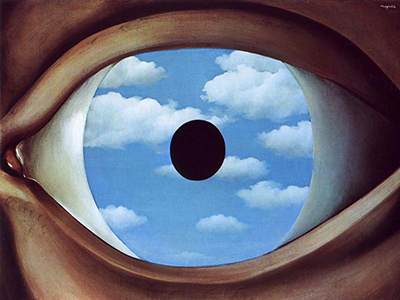Rene Magritte painted The False Mirror in 1928. The painting is also known as Le Faux Miroir.
What is interesting is that the name was penned by the surrealist writer and fellow Belgium, Paul Nougé. The painting was previously owned by Man Ray, a photographer from Belgium, from 1933 through to 1936.
Today this oil on canvas painting is housed in the Museum of Modern Art in New York. The False Mirror is a magical surrealistic painting.
The False Mirror is a painting of a large, unblinking eye, with no eyelashes present. A large black pupil is located in the centre. The iris is painted to represent a bright blue sky with floating, white, fluffy clouds.
The iris appears to be full of life and almost luminescent, while the pupil is black and dead. The observer can also see the white sclera of the eye. The upper and lower lids of the eye almost appear to be stretched, giving the eye a bulbous like quality.
The emotion that instantly springs to mind when observing The False Mirror, is that of wonder and fear, as this is the emotion that has been represented in this surrealist paint form.
The False Mirror is widely acknowledged to represent the limitations of human vision. A mirror reflects what is places before it, whereas the eye is subjective, it filters and processes those images that it wishes to see.
It does not merely reflect, but thinks and feels about those images that the brain processes. The eye in The False Mirror also serves several purposes. As an observer we can look through the painting, we look through the eye towards the blue sky filled with white floating clouds.
It is almost as if we are looking through a window that is in the shape of an eye. What Magritte has managed to achieve with The False Mirror, is the sense that the observer is also being watched by the eye. Does the eye see what we see? The observer and observed become one identity, with the identifiers of each becoming somewhat blurred.
The False Mirror is an incredibly haunting picture. This is due to many factors. We have the bold and striking nature of the eye that almost appears to jump out of the painting. It is all seeing, unblinking.
The harshness of the lines that surround the eye, the lashless lids and the gaping black hole of the pupil, all help to juxtapose the softness of the bright blue sky and almost dreamlike quality that it represents. The painting though is perfectly balanced, with its use of core colours and the black pupil as its central, focal point.
As we observe the image we question if the blue sky and clouds are part of the eye? Is the eye simply a reflection of the sky? Or are we viewing the image through an eye shaped looking glass? All of these assumptions are possible and all are valid. The painting raises many philosophical questions about human nature and how we perceive the world and those around us. We have both created and experienced the environment around us, and this is represented in the fact that the eye iboth sees and is a reflection of the world.
The False Mirror was one of several pieces of art that was produced by Magritte between the First and Second World Wars. It is therefore probable that his art, and in particular this painting, were influenced by the stark and haunting conditions of war. Perhaps the eye represents a dreamlike state and an environment that is constructed from peace and tranquility.




